spare wheel AUDI TT ROADSTER 2014 Owners Manual
[x] Cancel search | Manufacturer: AUDI, Model Year: 2014, Model line: TT ROADSTER, Model: AUDI TT ROADSTER 2014Pages: 244, PDF Size: 60.87 MB
Page 188 of 244
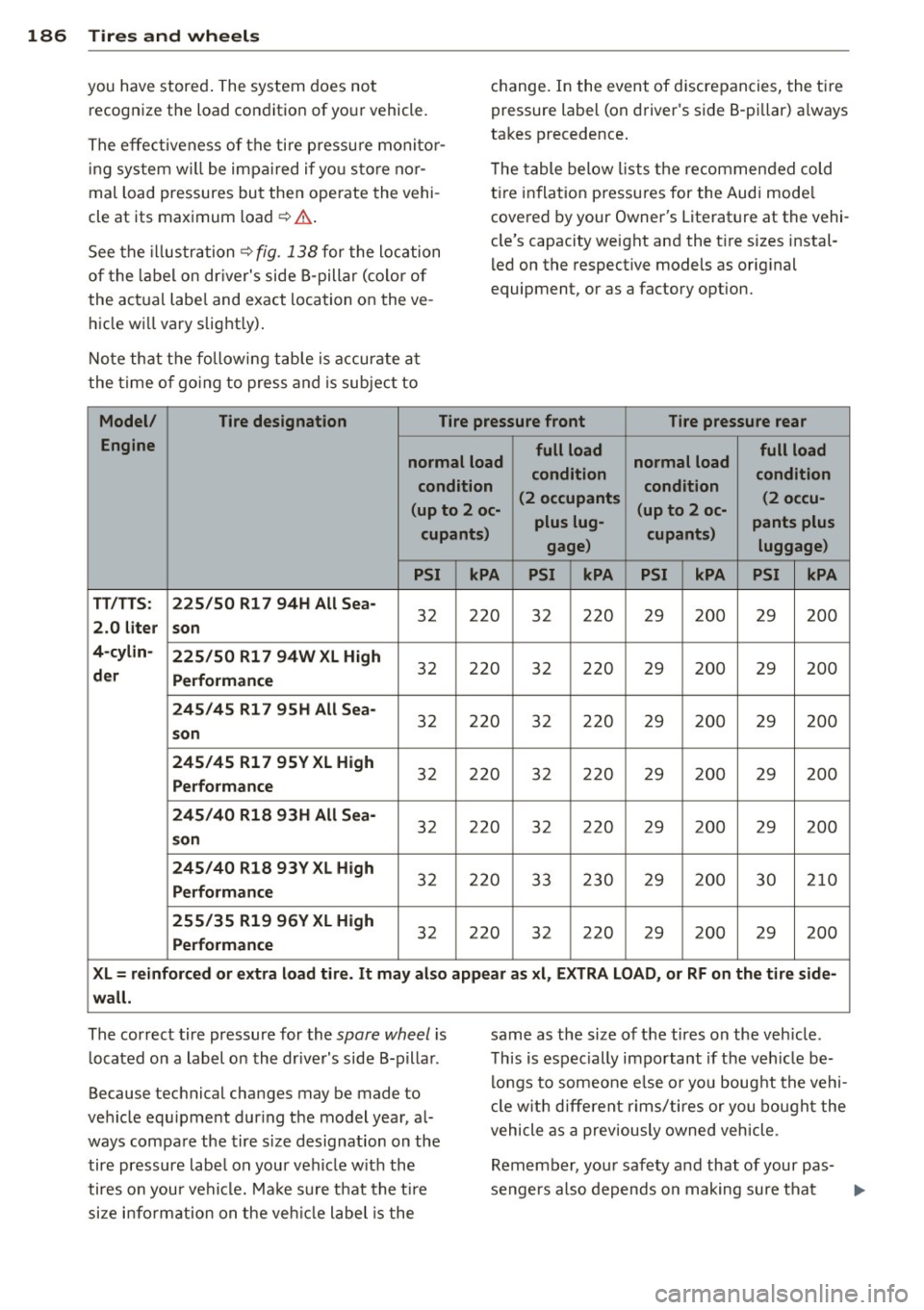
186 Tire s and wheel s
you have stored . The system does not
recognize the load condition of your vehicle.
The effectiveness of the tire pressu re monito r
ing system w ill be impaired if yo u store nor
mal load pressures but then operate the vehi
cle at its maximum load¢.&..
See the il lustration¢
fig. 138 for the location
of the label on dr iver's side 8-pillar (color of
the actua l labe l and exact location on the ve
hicle wi ll vary slightly).
Note that the followi ng tab le is accurate a t
the time o f go ing to press and is subject to change. In the
event of discrepancies, the t ire
pressure label (on driver's side 8-pi llar) a lways
takes precedence .
T he table below lists the recommended cold
ti re inflation pressu res for the Audi mode l
covered by your Owner's Literature at the vehi
cle's capacity weight and the t ire sizes instal
l ed on the respective models as original
equipment, or as a factory option.
Model/ Tire designation
Tire pressure front Tire pressure rear
Engine full load full load
no rmal load
condition normal load
condition
condition (2 occupants condition
(2 occu-
( up to 2 oc-
plus lug- (up to 2 oc-
pants plus
cupants)
gage) cupants)
luggage)
PSI kPA PSI kPA PSI kPA PSI kPA
TT /TTS : 22 5/50 Rl 7 94H All Sea -
32 220 32 220 29 200 29 200 2.0 liter son
4-c ylin-225 /50 Rl 7 94W XL High
d er
Perf orm ance
32 220 32 220 29 200 29 200
2
45 /4 5 Rl 7 95 H All Sea-
32 220 32 220 29 200 29 200 son
245 /45 Rl7 95YX L High
32 220 32 220 29 200 29 200 Perf ormance
245 /40 R1 8 93H All S ea-
32 220 32 220 29 200 29 200 son
2 45 /40 Rl8 9 3Y XL High
32 220 33 230 29 200 30 210 Perform ance
25 5/35 Rl 9 96Y XL Hi gh
32 220 32 220 29 200 29 200 Perf or mance
X L= r ein for ce d or e xtra lo ad tire . It m ay also a ppear as xl, EX TRA LO AD, or RF on th e tire side-
w all.
The correct tire pressure for the spare wheel is
l ocated on a label on the driver's side 8-pillar.
Because technical changes may be made to
vehicle equ ipment dur ing the model year, al
ways compare the tire size designation on the
tire pressure labe l on your vehicle w ith the
tires on your vehicle. Ma ke sure that the tire
size information on the vehicle label is the same
as the size of the tires on the veh icle.
T his is espec ially important if the veh icle be
longs to someone e lse or you boug ht the vehi
cle w ith different rims/tires or you bought the
vehicle as a previously owned veh icle.
Remember, your safety and that of your pas-
sengers also depends on making sure that
II>-
Page 190 of 244
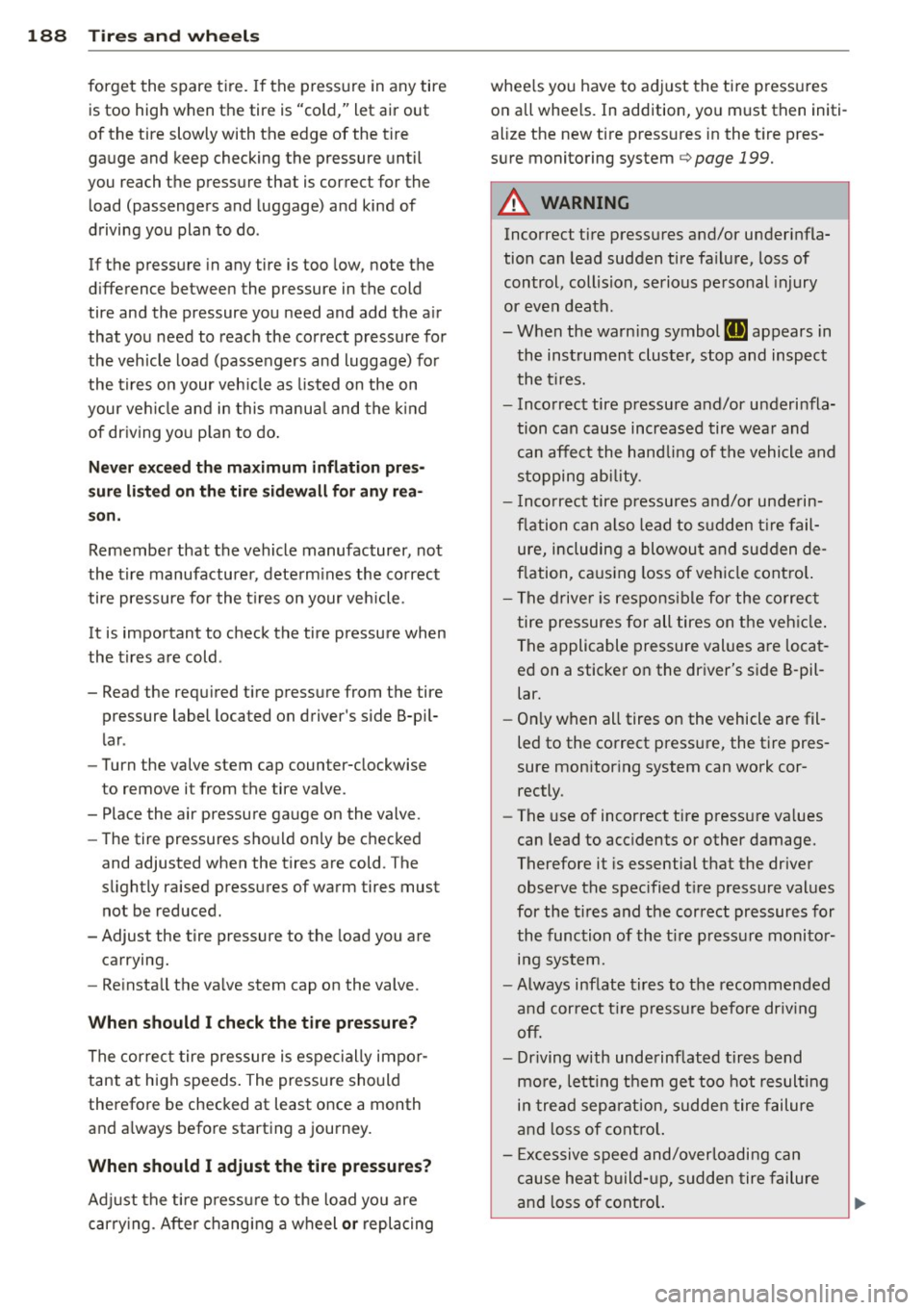
188 Tire s and wheel s
forget the spare tire. If the pressure in any tire
is too high when the tire is "cold," let air out
of the tire slowly with the edge of the tire
ga uge and keep checking the pressure until
you reach the pressure that is correct for the
load (passengers and luggage) and kind of
driving you plan to do.
If the pressure in any tire is too low, note the
d ifference between the pressure in the cold
tire and the pressure you need and add the air
that you need to reach the correct pressure for
the vehicle load (passengers and luggage) for
the tires on your veh icle as listed on the on
your ve hicle and in this manua l and the kind
of dr iving you p lan to do .
Never exc eed th e maximum inflati on pres
sure listed on th e tir e s idewall for any rea
s on.
Remembe r that the vehicle manufacturer, not
the t ire manufactu rer, determ ines the correct
tire pressure for the t ires on your vehicle.
It is important to check the tire pressure when
the t ires a re cold .
- Read the requ ired tire press ure from the tire
pressure label located on driver's side B-pil
lar .
- Turn the valve stem cap counter-clockwise
to remove it from the tire valve.
- Place the air pressure gauge on the valve.
- The tire pressures sho uld only be checked
and adjusted when the tires are cold. The
slightly raised pressures of warm tires must
not be reduced.
- Adjust the tire pressure to the load you are
carrying.
- Re insta ll the valve stem cap on the valve.
Wh en should I check the tir e pr essure?
The correct tire pressure is espe cially impor
tant at high speeds . The pressure should
therefore be checked at least once a month
and a lways before starting a journey.
When should I ad ju st the tire pressures?
Adj ust the t ire p ressu re to the load yo u are
carry ing . After changing a wheel
or replacing whee
ls you have to adjust the tire p ressures
o n all whee ls. In addition, yo u m ust then initi
alize the new tire press ures in the t ire pres
s u re monitoring system¢
page 199.
A WARNING
Incorrect tire pressures and/or underinfla
tion can lead sudden tire fa ilure, loss of
control, collision, serious pe rsonal injury
or even death.
- When the warn ing symbol
RI] appears in
the instrument cluster, stop and inspect
the t ires.
- Incorrect tire pressure and/or underinfla
tion can cause increased tire wea r and
can affect the handling of the vehicle and
s topping ability.
- I nco rrect tire pressures and/or underin
f lation can a lso lead to s udden t ire fail
ure, including a blowout and su dden de
flation, ca using loss of veh icle cont ro l.
- The drive r is responsible for the co rrec t
tire pressures for all tires on the veh icle .
The applicable pressure values are loca t
ed on a sticker on the driver's side B -pil
lar.
- On ly when all tires on the vehicle are fil
led to the correct pressu re, the tire pres
sure mon itor ing system can work cor
rectly.
- The use of incorrect tire pressu re va lues
can lead to acc idents or other damage.
Therefore it is essential that the driver
observe the spec ified t ire pressure values
for the tires and the correct pressures for
the function of the t i re p ress ure monito r
ing system.
- Always inf late tires to the recommended
and correct t ire pressure before dr iv ing
off.
- Driving with unde rinf lated tires bend
mo re, letting them get too hot resulting
in tre ad separation, sudden tire failure
and loss of cont ro l.
- Excessive speed and/overloading can
cause heat b uild- up, sudden tire failure
and loss of cont ro l.
Page 195 of 244
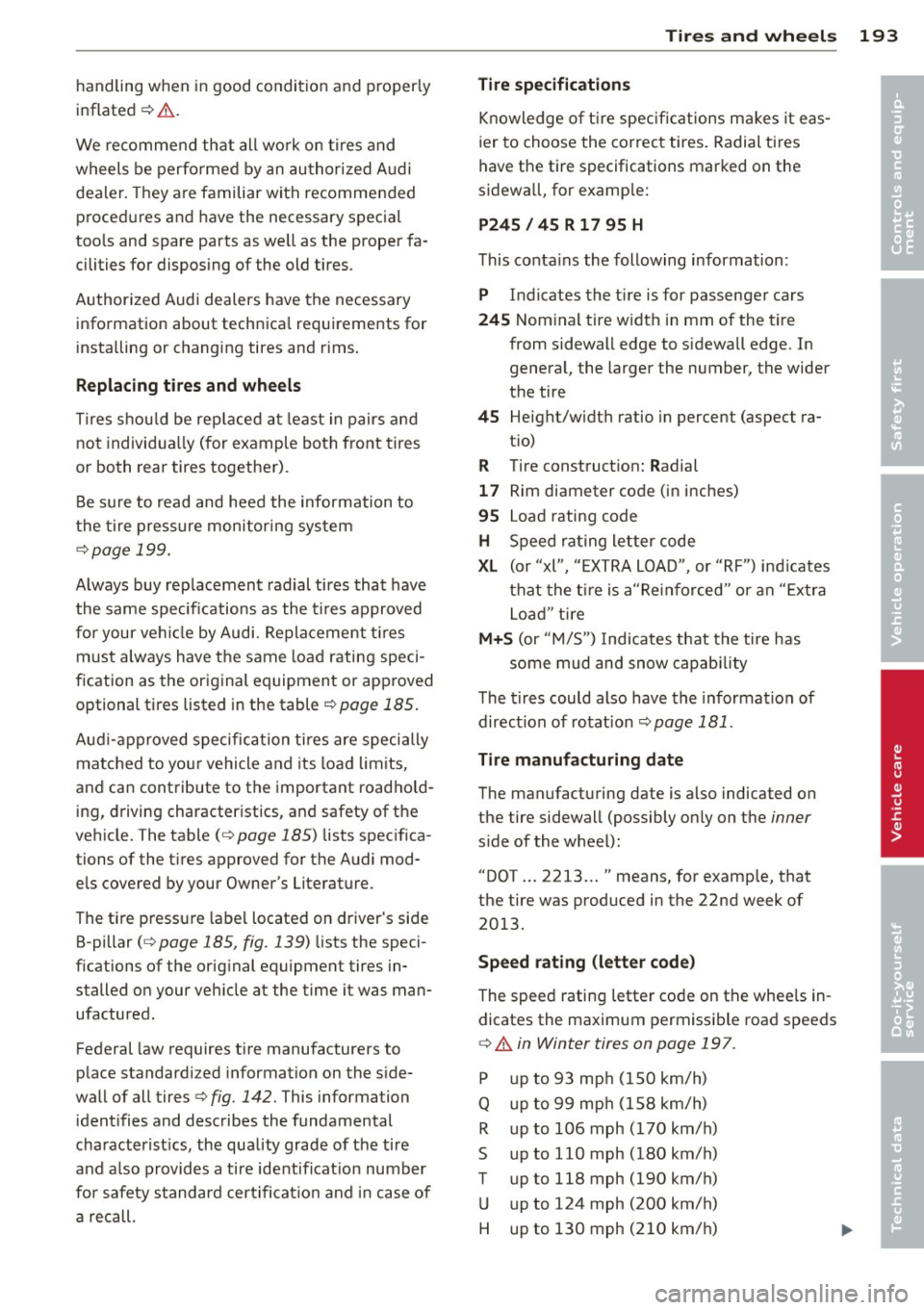
handling when in good condition and properly
inflated¢&..
We recommend that all wo rk on tires and
wheels be perfo rmed by an au thorized A udi
dea ler. They are familiar with recommended
proced ures and have the necessary special
too ls and spare parts as we ll as the proper fa
cilities for dispos ing of the old tires.
Authorized Audi dealers have the necessary information about technica l requirements for
insta lling or changing tires and r ims.
R eplacing t ire s an d wheel s
Tires s hou ld be rep laced at least in pairs and
not individua lly (for example both front t ires
or both rear tires together).
Be sure to read and heed the information to
the t ire pressure monitor ing system
¢page 199.
Always buy rep lacement radial tires that have
the same specifications as the tires approved
for your ve hicl e by Audi. Replacement t ires
must always have the same load rating speci
fication as the original equipment or approved optional tires listed in the table
¢ page 185.
Aud i-approved specifica tion ti res are specially
matched to you r vehicle and its load limits,
and can contribute to the important road ho ld
ing, driving characteristics, and safety of the
vehicle. The table
( q page 185) lists specifica
tions of the t ires approved for the Audi mod
e ls covered by your Owner's Literature .
The tire pressure labe l located on driver's side
B-pillar
( q page 185, fig. 139) lists the speci
fications of the orig inal equipment tires in
stalled on your veh icle at the time it was man
ufactured .
Federal law requires t ire manufacturers to
place standard ized information on the s ide
wall of all tires
q fig. 142. This information
ident ifies and describes the fundamental
characterist ics, the quality grade of the tire
and a lso provides a tire identificat ion number
for safety standard certificat ion and i n case of
a recall.
Tire s an d wheel s 193
Tire specification s
Knowledge of tire specifications makes it eas
ier to choose the co rrect tires. Radial tires
have the tire specifications marked on the
sidewa ll, for examp le:
P245 / 45 R 17 95 H
This conta ins the following information:
P Indicates the tire is for passenger cars
2 45 Nominal tire width in mm of the tire
from sidewall edge to sidewall edge. In general, the larger the number, the wider
the tire
45 Height/w idt h ratio in percent (aspect ra-
tio)
R Tire construction: Radial
17 Rim diameter code (in inches)
95 Load rating code
H Speed rat ing letter code
XL (or "xl", "EXTRA LOAD", or "RF") ind icates
that the t ire is a"Re inforced" o r an " Extra
Load " tir e
M+5 (or "M/S") Indicates that the tire has
some mud and snow capabi lity
The t ires could also have the informat ion of
direction of rotat ion
q page 181 .
Tire manuf acturing d ate
The manufacturing date is also indicated on
the tire sidewall (possibly on ly on the
inner
s ide of the wheel) :
"DOT ... 2213 ... "means, for examp le, that
the tire was produced in the 22nd week of
2013.
Sp eed rating (letter code )
The speed rating letter code on the whee ls in
dicates the maximum permissible road speeds
q .&. in Winter tires on page 197.
p up to 93 mp h (150 km/h)
Q up to 99 mp h (158 km/h)
R up to 106 mph (170 km/h)
s up to 110 mph (180 km/h)
T up to 118 mph (190 km/h)
u up to 124 mph (200 km/h)
H u
p to 130 mph (210 km/h)
•
•
Page 197 of 244
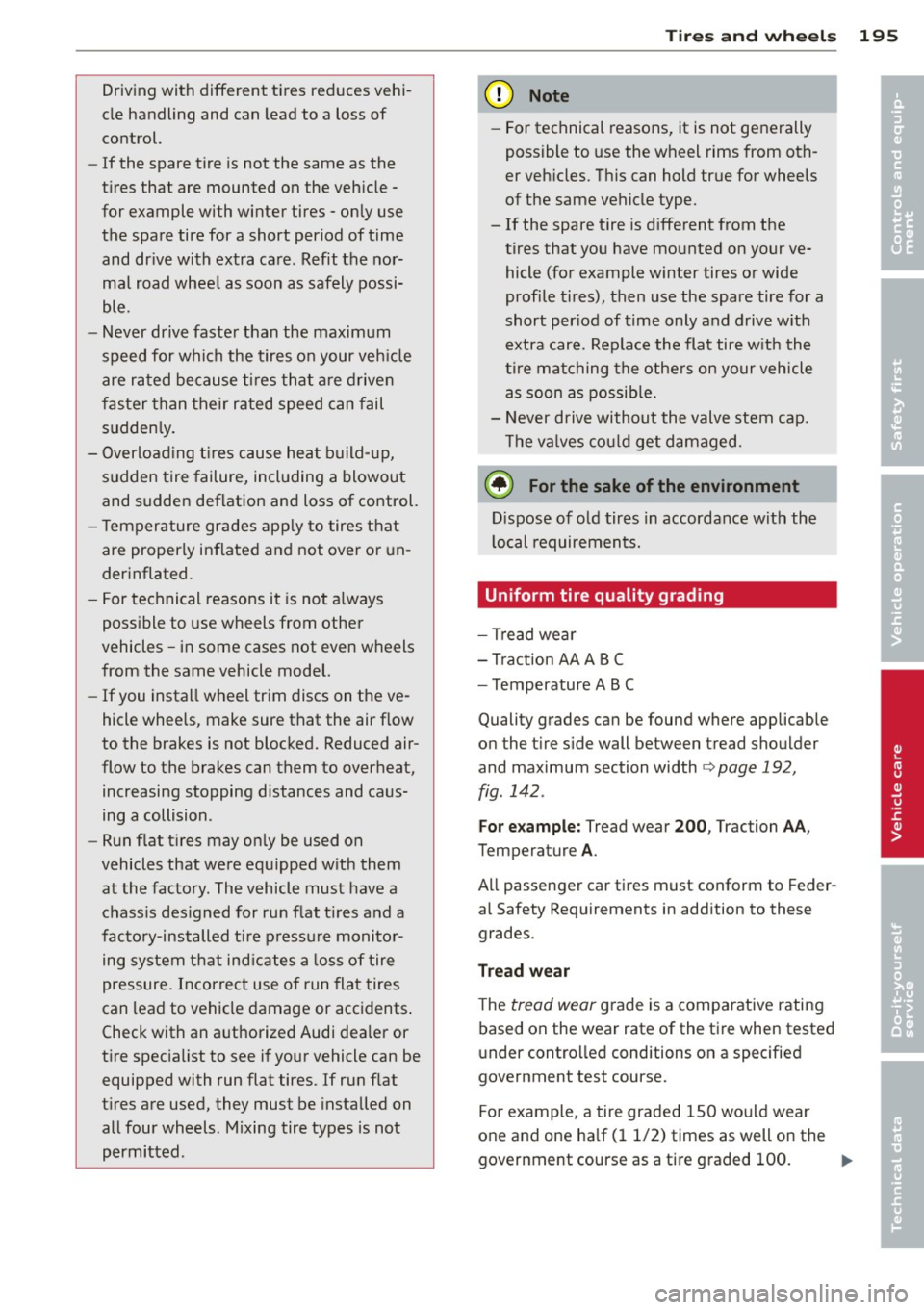
Driving with different tires reduces vehi
cle handling and can lead to a loss of
control.
- If the spare tire is not the same as the
tires that are mounted on the vehicle -
for example with winter tires -only use
the spare tire for a short period of time
and drive with extra care. Refit the nor
mal road wheel as soon as safely possi
ble.
- Never drive faster than the maximum
speed for which the tires on your vehicle
are rated because tires that are driven
faster than their rated speed can fail
suddenly.
- Overloading tires cause heat build-up,
sudden tire failure, including a blowout
and sudden deflation and loss of control.
- Temperature grades apply to tires that
are properly inflated and not over or un
deri nflated.
- For technical reasons it is not always
possible to use wheels from other
vehicles -in some cases not even wheels
from the same vehicle model.
- If you install wheel trim discs on the ve
hicle wheels, make sure that the air flow
to the brakes is not blocked. Reduced air
flow to the brakes can them to overheat, increasing stopping distances and caus
ing a collision.
- Run flat tires may only be used on
vehicles that were equipped with them
at the factory . The vehicle must have a
chassis designed for run flat tires and a
factory-installed tire pressure monitor ing system that indicates a loss of tire
pressure. Incorrect use of run flat tires
can lead to vehicle damage or accidents.
Check with an authorized Audi dealer or
tire specialist to see if your vehicle can be
equipped with run flat tires .
If run flat
tires are used, they must be installed on
all four wheels. Mixing tire types is not
permitted .
Tires and wheels 195
@ Note
-For technical reasons, it is not generally
possible to use the wheel rims from oth
er vehicles. This can hold true for wheels
of the same vehicle type.
- If the spare tire is different from the
tires that you have mounted on your ve
hicle (for example winter tires or wide
profile tires), then use the spare tire for a
short period of time only and drive with
extra care. Replace the flat tire with the
tire matching the others on your vehicle
as soon as possible.
- Never drive without the valve stem cap .
The valves could get damaged.
(® For the sake of the environment
Dispose of old tires in accordance with the
local requirements.
Uniform tire quality grading
- Tread wear
- Traction AA A B C
- Temperature ABC
Quality grades can be found where applicable
on the tire side wall between tread shoulder
and maximum section width
¢ page 192,
fig. 142 .
For example: Tread wear 200, Traction AA,
Temperature A.
All passenger car tires must conform to Feder
al Safety Requirements in addition to these
grades.
Tread wear
The tread wear grade is a comparative rating
based on the wear rate of the tire when tested
under controlled conditions on a specified
government test course.
For example, a tire graded 1S0 would wear
one and one half (1 1/2) times as well on the
government course as a tire graded 100. •
•
Page 198 of 244
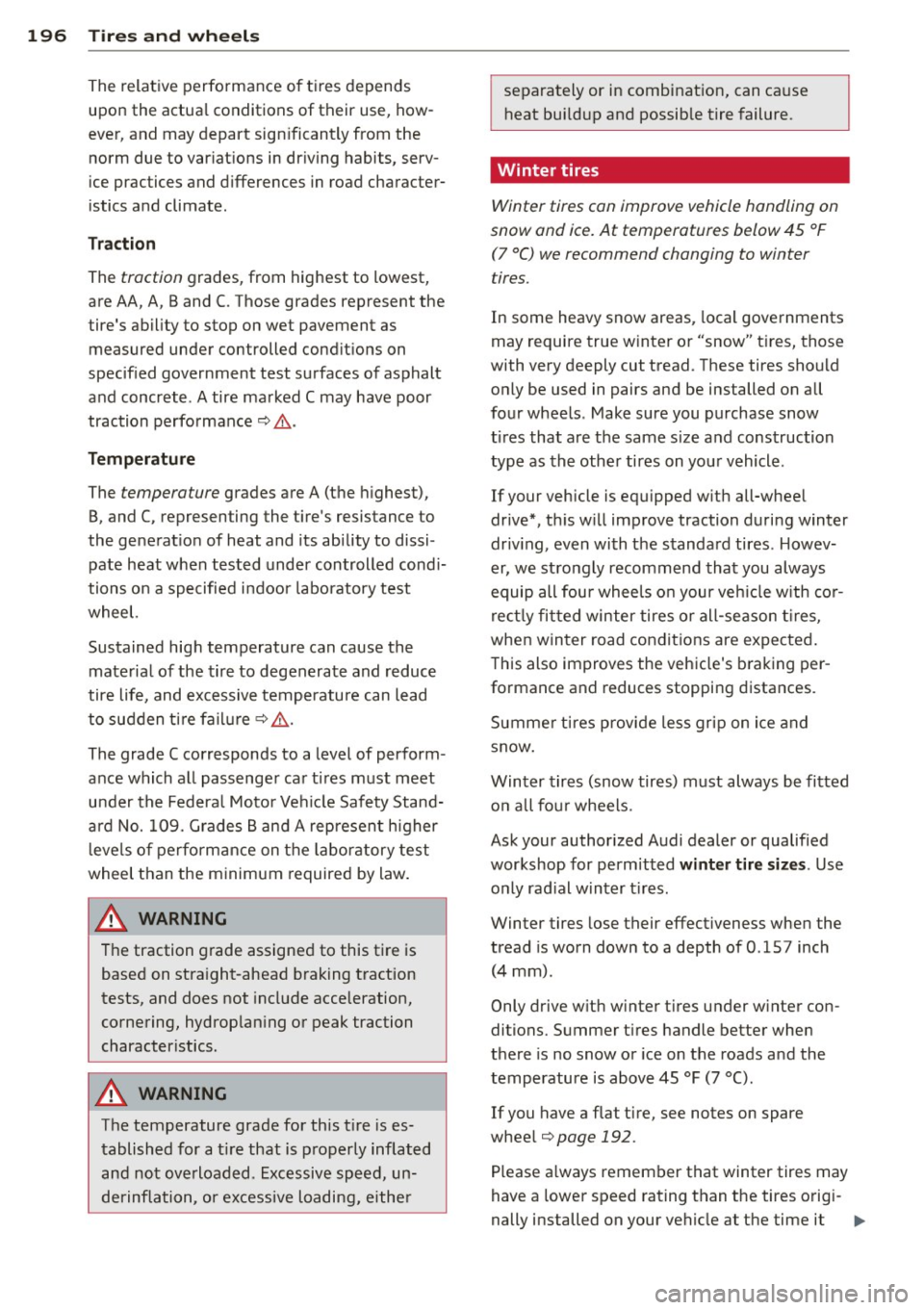
196 Tire s and wheel s
The relat ive performance of tires depends
upon the actua l conditions of their use, how
ever, and may depart sign ificantly from the
norm due to var iat ions in dr iving habits, serv
ice practices and differences in road character
istics and climate.
Tr action
The traction grades, from highest to lowest,
are AA, A, Band
C. Those grades represent the
tire's ability to stop on wet pavement as measured under controlled cond itions on
specified government test surfaces of asphalt
and concrete . A tire marked C may have poor
traction performance¢ .&,.
Temperature
The temperature grades are A (the h ighest),
B, and
C, representing the t ire's resistance to
the generat ion of heat and its abi lity to dissi
pate heat when tested under controlled cond i
tions on a specified indoor laboratory test
wheel.
Sustained high temperature can cause the
materia l of the tire to degenerate and reduce
tire life, and excessive temperature can lead
to sudden ti re fa il ur e~ .&, .
The grade
C corresponds to a level of perform
ance which all passenger ca r tires must meet
u nder the Federa l Moto r Veh icle Safety Stand
a rd No.
1 09. Grades Band A represent higher
l eve ls of performance on t he laboratory test
wheel than the minimum required by law .
.&_ WARNING
The traction grade assigned to this tire is
based on straight-ahead braking traction
tests, and does not include acceleration,
cornering , hydrop lan ing or peak traction
character istics.
.&_ WARNING
The temperature grade for this t ire is es
tablished for a t ire that is properly inflated
and not overloaded . Excessive speed, un
derinflation, or excessive loading, eithe r
-
separately or in combination, can ca use
heat bui ldup and possib le tire failure.
Winter tires
Winter tires can improve vehicle handling on
snow and ice. At temperatures below 45 °F (7 °C) we recommend changing to winter
tires.
In some heavy snow areas, local governments
may require true winter or "snow" tires, those
with very deeply cut tread . These tires should
only be used in pairs and be installed on all
four wheels . Make sure you purchase snow
tires that are the same s ize and construction
type as the othe r tires on your vehicle .
If your vehicle is equipped w ith all-whee l
drive", th is w ill improve traction during winter
driv ing, even with the standard tires . Howev
er, we st rongly recommend that you always
equip all fou r whee ls o n your ve hicle w ith cor
rect ly fit ted winter tires or all -season t ires,
when w inter road condit ions are expected.
T his also improves the vehicle's braking per
formance and reduces stopping distances.
Summe r tires provide less grip on i ce and
snow.
Winter tires (snow tires) must always be fitted on all four whee ls .
Ask your author ized Audi dealer or qualified
workshop for permitted
winter tir e siz es. Use
on ly rad ial winter t ires .
Winter tires lose their effectiveness when the
tread is worn down to a depth of
O .15 7 inch
(4 mm).
Only drive w ith w inter t ires under winter con
ditions. Summer t ires handle better when
there is no snow or ice on the roads and the
temperature is above 45 °F (7 °() .
If you have a flat ti re, see notes on spare
whee l
¢page 192.
Please a lways remember that winter tires may
have a lower speed rating than the tires origi -
nally installed on your vehicle at the time it .,.
Page 201 of 244
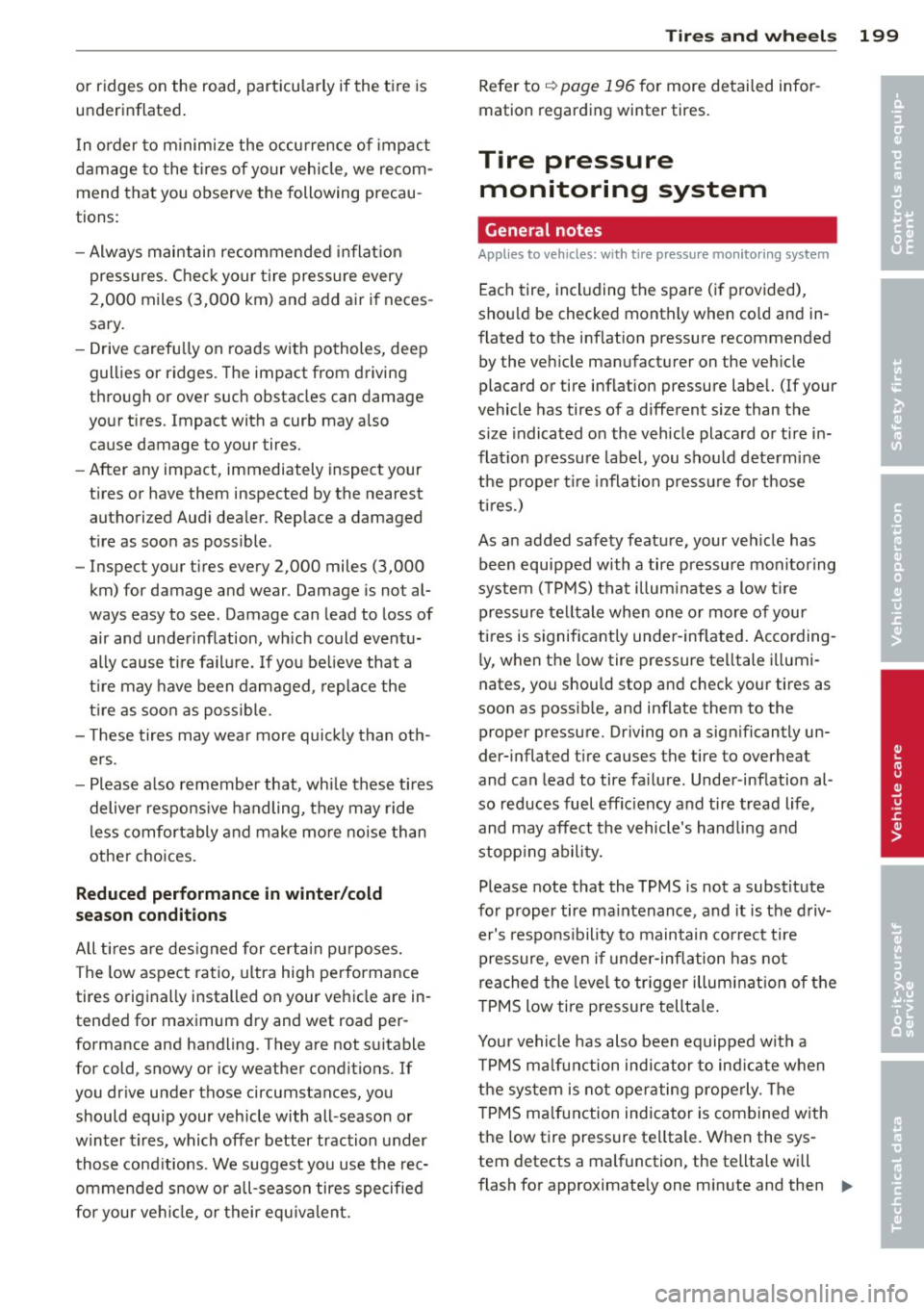
or ridges on the road, particularly if the tire is underinflated .
I n o rder to m inim ize the occu rrence of impact
damage to the t ires of your vehicle, we recom
mend that you observe the following precau
tions :
- Always maintain recommended inflat ion
pressures. Chec k your tire pressure every
2,000 miles (3 ,000
km) and add air if neces
sary.
- Drive carefu lly on roads with potholes, deep
gullies or ridges. The impact from driving
through or over such obstacles can damage
your tires. Impact with a curb may a lso
cause damage to your tires.
- After any impact, immediately inspect your
tires or have them inspected by the nearest
authorized Aud i dealer. Replace a damaged
t ire as soon as possible .
- Inspect your t ires every 2,000 miles (3,000
km) for damage and wear . Damage is not al
ways easy to see. Damage can lead to loss of
air and underinflation, wh ich could eventu
ally cause tire failure . If you be lieve that a
t ire may have been damaged , replace the
t ire as soon as possible.
- T hese tires may wea r mo re qui ckly than ot h
ers.
- Please a lso remember that, whi le these tires
deliver respons ive handling, they may ride
l ess comfortably and make mo re noise than
othe r choices.
Reduced perf ormance in winter /cold
s eason condition s
All tires are des igned for certa in pu rposes.
The low aspect ratio, ultra high performance
tires originally installed on your veh icle are in
tended for maximum dry and wet road per
formance and handling . They are not suitable
for cold , snowy or icy weather condit ions .
If
you dr ive under those circums tances, you
should equip your vehicle with all -season or
winter tires, which offer better traction under
those cond itions . We suggest you use the rec
ommended snow or all-season tires specified
for your ve hicle, or their equ ivalent.
Tire s an d wheel s 199
Refer to q page 196 for more detailed infor
mation regarding winter tires.
Tire pressure monitoring system
General notes
Applies to veh icles: w ith t ire pressure monitoring system
Each tire, incl uding the spare (i f provided),
shou ld be checked monthly when co ld and in
flated to the inf lation pressure recommended
by the veh icle manufacturer on the veh icle
placard or tire inflation pressure label. (If your
vehicle ha s tires of a different size than the
s ize indicated on the vehicle placard or tire i n
flat ion pressu re labe l, you shou ld dete rm ine
the p roper t ire inflation p ress ure fo r those
t i r es.)
As an added safety feature , your ve hicle has
been equipped with a tire pressure mon ito ring
system ( TPMS) that illum inates a low ti re
pressure te lltale when one or more of your
tires is significant ly under -inflated . Acco rding
ly, when the low tire pressure te lltale i llumi
nates, you should stop and check your tires as
soon as possib le, and inflate them to the
proper pressure. Driving on a sign ificantly un
der- inflated t ire causes the tire to overheat
and can lead to tire fa ilure . Under -inflation al
so reduces fuel effic iency and tire tread life,
and may affect the vehicle 's hand ling and
stopp ing ability.
Please note that the TPMS is not a substitute
for proper tire ma intenance, and it is the driv
er's respons ibility to maintain co rrect tire
pressure, even if under-inflation has not
rea ched the level to tr igger illum inat ion of the
T PMS low tire pressure tellta le .
Your vehicle has also been equipped with a
T PMS ma lfunction indicator to ind icate when
the system is not operating prope rly . T he
T PMS ma lfunction indicator is combined with
the low tire pressure te lltale. When the sys
tem detects a malfunction , the telltale wi ll
flash for approximate ly one minute and then ..,_
•
•
Page 213 of 244
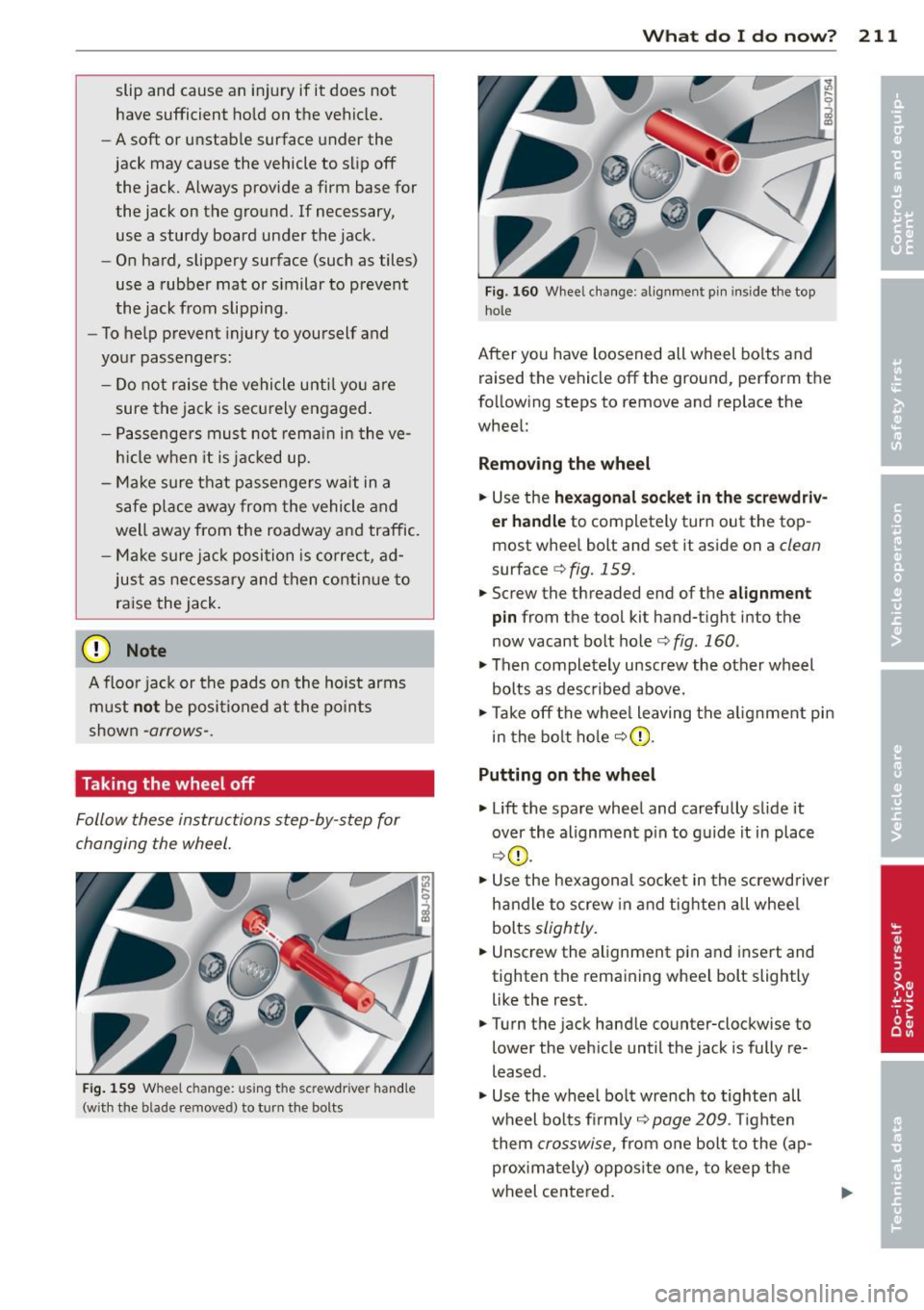
slip and cause an injury if it does not
have sufficient hold on the veh icle.
- A soft or unstable surface under the
jack may cause the vehicle to slip off the jack. Always provide a firm base for
the jack on the ground. If necessary, use a sturdy board under the jack .
- On hard, slippery surface (such as tiles)
use a rubber mat or similar to prevent
the jack from slipping .
- To help prevent injury to yourself and
your passengers:
- Do not raise the vehicle u nti l yo u are
sure the jack is sec urely engaged .
- Pa ssenge rs must not remai n in the ve
h icle when it is jacked up.
- Make sure that passengers wait in a
safe pl ace away from the vehicle and
well away from the roadway and traffic.
- Make sure ja ck position is correc t, ad
just as necessary and then continue to
ra ise the jack .
(D Note
A floor jac k or the pads o n the hoist arms
m ust
n ot be po sit ioned at the po ints
shown
-arrows- .
Taking the wheel off
Follow these instructions step-by-step for
changing the wheel.
Fig . 159 W hee l ch ange : us ing th e sc rewdr ive r hand le
(w ith t he blade re m ove d) to turn t he bo lts
What do I d o now ? 211
Fig . 1 60 W hee l cha nge : alignmen t pin inside the top
ho le
After yo u have loosened all wheel bo lts and
raised the vehicle off the ground, perform the
follow ing steps to remove and replace the
whee l:
Remo ving the wheel
.,. Use the he xagonal socket in the scr ewdri v
er handle
to completely turn out the top
most whee l bolt and set it aside on a
clean
surface ¢ fig. 159.
.,. Screw the threaded end of the alignment
pin
from the tool kit hand-tight into the
now vacant bolt hole¢
fig. 160 .
.,. Then completely unscrew the other wheel
bolts as desc ribed above.
.,. Take off the whee l leaving the alignment pin
in the bo lt ho le ¢ (D.
Putting on th e wheel
.,. Lift the spare wheel and carefully slide it
over the alignment p in to guide it in place
Q (D .
.,. Use the hexagona l socket in the screwd river
handle to screw in and tig hten all whee l
bolts
slightly .
.,. Unscrew the alignment p in and insert and
tighten the remaining wheel bolt slightly like the rest .
.,. Turn the jack handle counter-clockwise to
lower the veh icle until the jack is fully re
leased .
.,. Use the whe el bo lt wrench to tighten all
wheel bo lts fi rm ly
Q page 209 . Tighten
t hem
crosswise, from one bolt to the (ap
proxima tely) opposi te one, to keep t he
wheel cente red.
Page 214 of 244
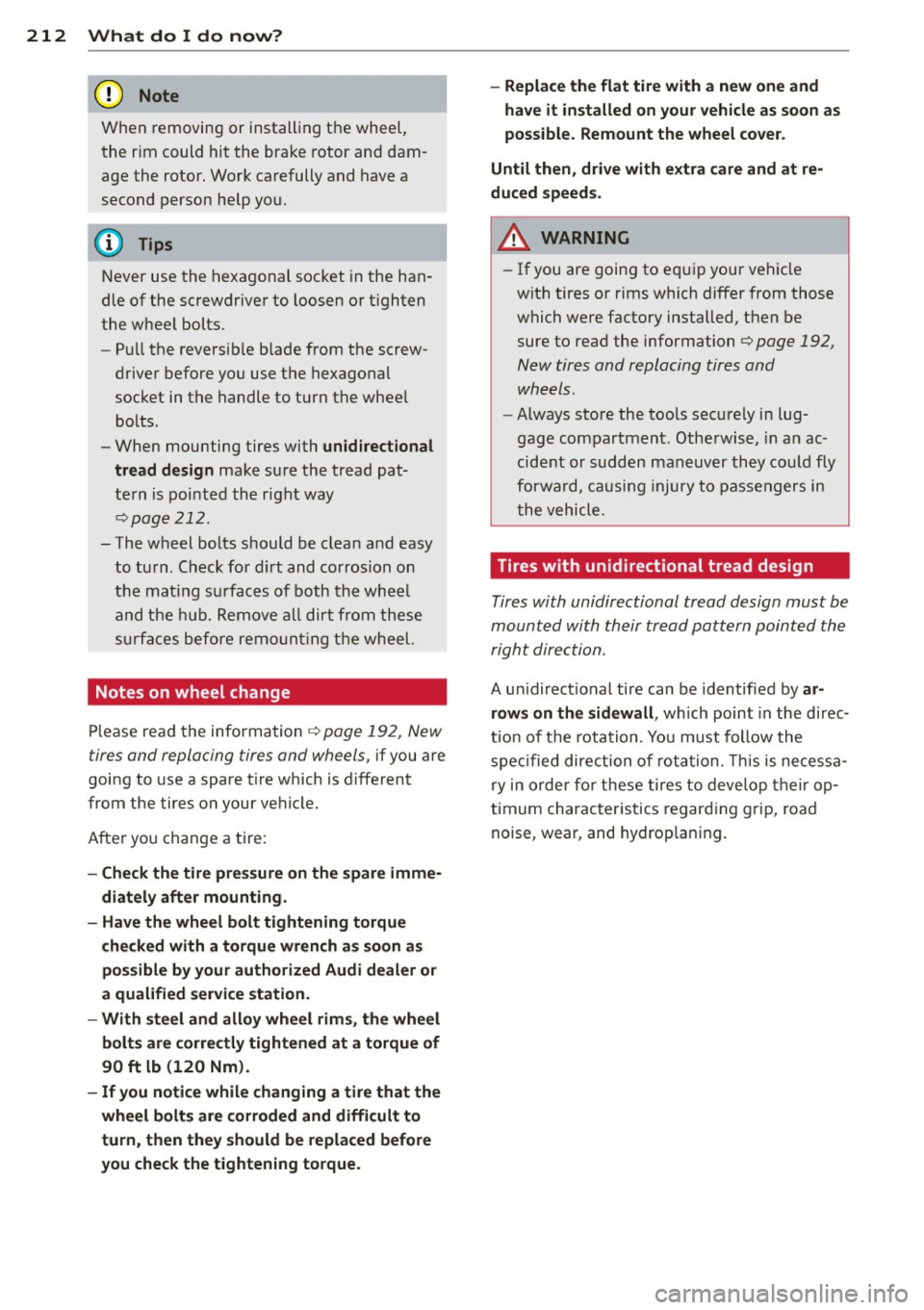
212 What do I do now?
When removing or installing the wheel,
the rim could hit the brake rotor and dam
age the rotor. Work carefully and have a
second person help you.
Never use the hexagonal socket in the han
dle of the screwdriver to loosen or t ighten
the wheel bolts.
- Pull the reversible b lade from the screw
driver before yo u use the hexagonal
socket in the handle to turn the whee l
bo lts.
- When mounting tires with
unid irectional
tread design
make sure the tread pat
tern is pointed the r ight way
~page 212.
- The wheel bolts should be clea n and easy
to tu rn . Check for d irt and corrosion on
the mat ing su rfaces of both th e whee l
and the h ub. Remove a ll dirt from these
su rfaces before remo unti ng the wheel.
Notes on wheel change
Pl ease read the informa tion ~ page 192, New
tires and replacing tires and wheels,
if you are
going to use a spare t ire which is different
from the tires on your vehicle.
After you change a tire :
-Check the tire pressure on the spare imme
diately after mounting .
- Have the wheel bolt tightening torque
che ck e d with a torqu e wrench a s soon as
possible b y your auth orized Audi dealer or
a qualified ser vice station .
- With steel and alloy wheel rims , the wheel
bolts are correctly tightened at a torque of
90 ft lb (1 20 Nm ).
- If y ou notice while changing a tire that the
wheel bolts are co rroded and difficult to
turn , then the y should be repl aced befo re
you check the t ightening torque . -
Repla ce the flat ti re with a new one and
have it installed on your veh icle a s soon as
possible. Remount the wheel cove r.
Until then , dr ive with extra care and at re
duced speed s.
_& WARNING
-
- If you are going to eq uip your vehicle
wit h tires or rims which differ from those
which were factory installed, then be
sure to read the information
9 page 192,
New tires and replacing tires and
wheels.
- Always store the tools secu rely i n lug
gage compartment. Othe rwise, in a n ac
cident or s udden maneuver they cou ld fly
forwa rd, causi ng injury to passengers in
the vehicle.
Tires with unidirectional tread design
Tires with unidirectional tread design must be
mounted with their tread pattern pointed the
right direction.
A un idirectional tire can be identified by ar
rows on the sid ewall ,
which point in the direc
tion of the rota tion. Yo u m ust follow the
specified direction of rota tion. This is ne ces sa
r y in order fo r these tires to develop t heir op
timum character istics regard ing grip, road
noise, wear, and hydrop laning.